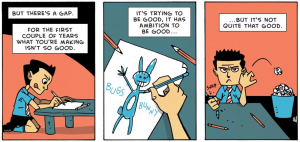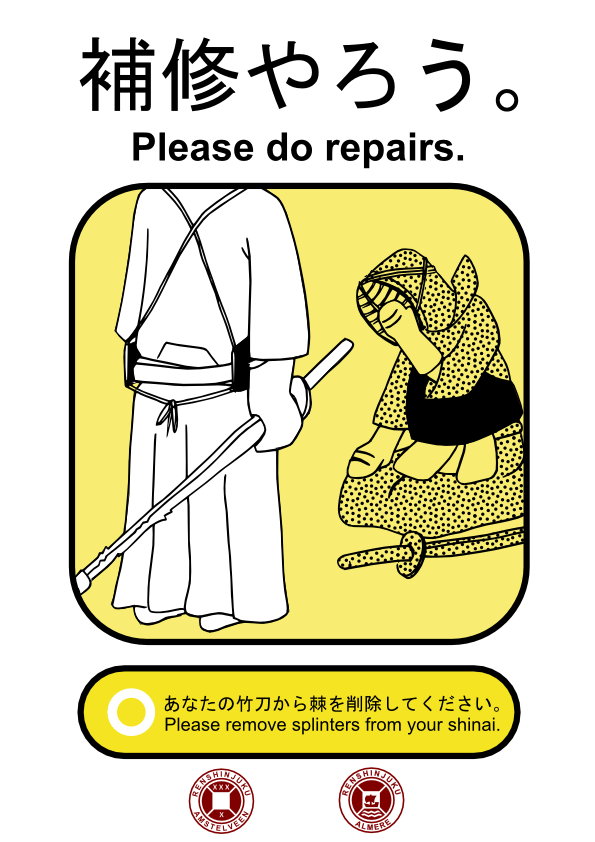
Continuing where we last left off regarding the requirements of hard work and perseverance…
American TV and radio producer Ira Glass once said the following. While his quote pertains to creative work I find that it applies equally to other activities, including martial arts. The image above is part of a wonderful comic by Zen Pencils (a source of great, inspiring comics!).
All of us who do creative work, like, y’know we get into it and we get into it because we have good taste. But it’s like there’s a gap. That for the first couple of years that you’re making stuff, what you’re making isn’t so good. It’s not that great. It’s trying to be good, it has ambition to be good, but it’s not quite that good. But your taste—the thing that got you into the game—your taste is still killer. And your taste is good enough that you can tell that what you’re making is kind of a disappointment to you. A lot of people never get past that phase and a lot of people at that point they quit.
…
I would just like to say to you—with all my heart—is that most everybody I know who does interesting creative work went through a phase of years where they had really good taste and they could tell what they were making wasn’t as good as they wanted it to be. They knew it fell short. It didn’t have the special thing that we wanted to have… Everybody goes through that… You’ve got to know that it’s totally normal.
…
The most important possible thing you can do is do a lot of work. Do a huge volume of work. Put yourself on a deadline so that every week or every month you know you’re going to finish one story. Because it’s only by actually going through a volume of work that you are actually going to catch up and close that gap and the work you’re making will be as good as your ambitions.
…
It takes a while. It’s going to take you a while. It’s normal to take a while. And you just have to fight your way through that, okay?
For kendo it’s the same, isn’t it? Many of recognize good kendo and we admire those in whom we perceive excellence. We know that our own kendo is lacking and we know where we want to go with it. It’s just that it will take a lot of hard work.
This page has a video of mr Glass’ speech.

We hebben het laatst gehad over kendo en de 10.000 uur regel.
Ira Glass, TV en radio producent, zei ooit het onderstaande. Hoewel zijn citaat gaat over creatief werk, vind ik dat het ook van toepassing is op andere dingen zoals martial arts. Bovenstaande tekening is onderdeel van deze prachtige strip van Zen Pencils (een bron van inspirerende strips!).
All of us who do creative work, like, y’know we get into it and we get into it because we have good taste. But it’s like there’s a gap. That for the first couple of years that you’re making stuff, what you’re making isn’t so good. It’s not that great. It’s trying to be good, it has ambition to be good, but it’s not quite that good. But your taste—the thing that got you into the game—your taste is still killer. And your taste is good enough that you can tell that what you’re making is kind of a disappointment to you. A lot of people never get past that phase and a lot of people at that point they quit.
…
I would just like to say to you—with all my heart—is that most everybody I know who does interesting creative work went through a phase of years where they had really good taste and they could tell what they were making wasn’t as good as they wanted it to be. They knew it fell short. It didn’t have the special thing that we wanted to have… Everybody goes through that… You’ve got to know that it’s totally normal.
…
The most important possible thing you can do is do a lot of work. Do a huge volume of work. Put yourself on a deadline so that every week or every month you know you’re going to finish one story. Because it’s only by actually going through a volume of work that you are actually going to catch up and close that gap and the work you’re making will be as good as your ambitions.
…
It takes a while. It’s going to take you a while. It’s normal to take a while. And you just have to fight your way through that, okay?
Voor kendo gaat’t zelfde op, niet waar? Velen van ons herkennen goede kendo en we kijken op naar hen die echt goed zijn in kendo. We weten dat ons eigen kendo nog lang niet goed genoeg is, maar we weten waar we heen willen. Om er te komen zullen we gewoon heel lang, heel hard moeten werken.
Deze pagina heeft een video van mr Glass’ toespraak.



